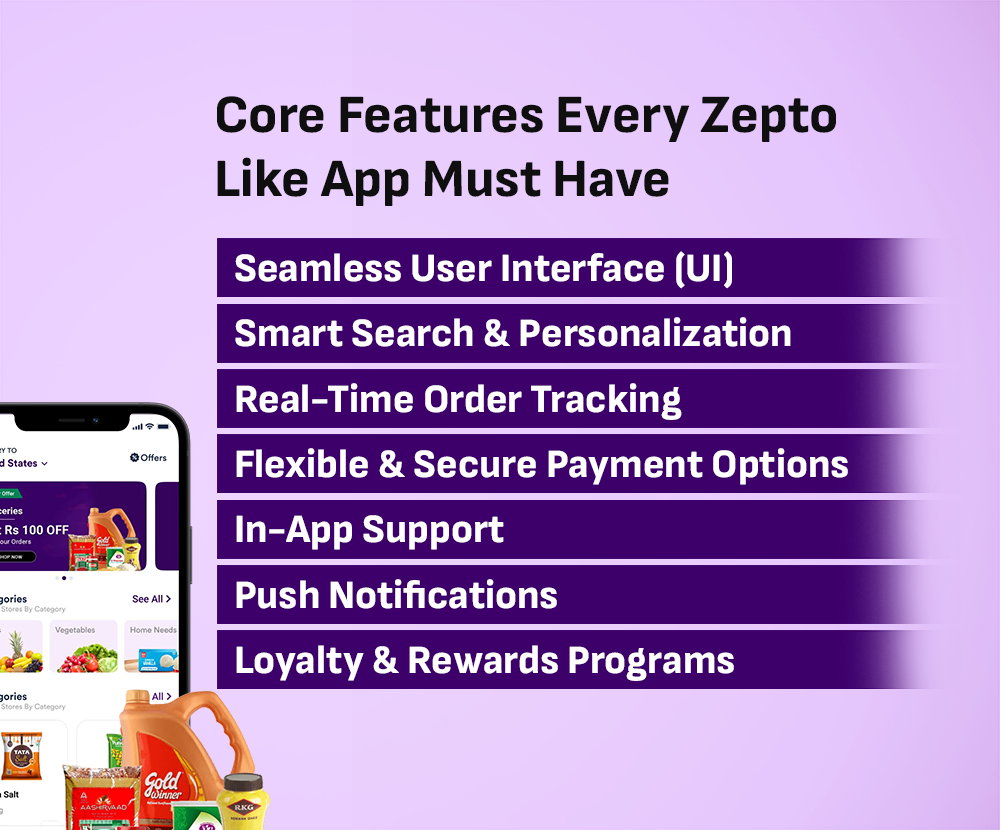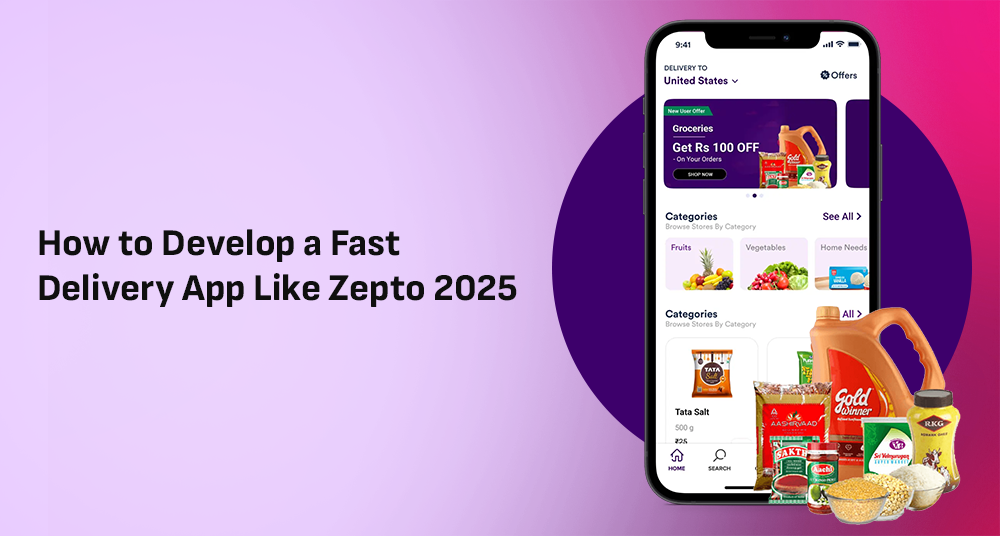In today’s fast-paced world, convenience is king — and the 10-minute delivery model is redefining how consumers receive their daily essentials. The post-pandemic era witnessed a dramatic shift in buying behavior, with safety, speed, and simplicity becoming top priorities. This demand for instant gratification gave rise to a new wave of food and grocery aggregators focused on ultra-fast delivery.
One of the standout players in this space is Zepto, which made headlines by promising 10-minute grocery deliveries and delivering on it. Launched in April 2022, Zepto quickly became a disruptor in the quick commerce sector, thanks to its hyper-local delivery model, dark store infrastructure, and seamless mobile app experience. This model has inspired many startups and businesses to rethink traditional delivery timelines.
So, if you’re considering entering the delivery space, now is the perfect time. With the right technology stack, business model, and app features, you too can build a high-performance 10-minute delivery app like Zepto and tap into this booming market.
This guide walks you through everything you need to know — from business planning and tech development to key features and monetization strategies — to help you launch your own rapid delivery platform.
What is 10 Minute Delivery Model?
The 10-minute delivery model is a hyperlocal logistics strategy where daily essentials like groceries and food are delivered to customers within 10 minutes of placing an order. It relies on strategically placed dark stores, real-time inventory tracking, and optimized delivery routes to ensure lightning-fast service, meeting the rising demand for instant convenience in urban areas.
The Secret Behind Zepto’s Popularity in the Quick Commerce Space
Zepto has emerged as a standout player in India’s quick commerce space, offering more than just speed—it delivers value, convenience, and smart user engagement. What makes Zepto so addictive? For starters, its 10-minute delivery promise isn’t just a marketing hook—it’s a reality, thanks to a network of well-positioned dark stores and an advanced logistics system.
But speed isn’t the only thing fueling its rise. Zepto’s daily cashback and free cash rewards (like ₹40, ₹50, or ₹75) keep users returning to the app regularly, turning everyday shopping into a rewarding experience. Their exclusive café offers, especially on coffees and quick bites, attract a new segment of on-the-go users looking for fast and affordable indulgence.
In addition, Zepto’s sleek user interface, seamless checkout, and reliable order tracking build trust and comfort. The platform’s ability to balance affordability, speed, and reliability has made it a go-to for urban households.
By combining tech-driven logistics with smart offers and a strong user experience, Zepto is setting the benchmark for what quick commerce should look like. It’s not just about delivering faster—it’s about delivering smarter.
From Idea to Launch: Building a Fast Delivery App Like Zepto
Identify Your Niche and Target Market
Before diving into development, define what you want to deliver—groceries, medicines, daily essentials, food, or even pet supplies. Knowing your niche helps refine your business model, marketing strategy, and technology stack. Study your competitors in the same niche, and evaluate what makes apps like Zepto stand out—speed, user experience, or unique promotions.
Choose the Right Business Model
Most instant delivery apps follow one of these models:
Dark Store Model: Products are stored in micro-warehouses closer to user locations.
Aggregator Model: Partners with local stores and restaurants.
Hybrid Model: A mix of both, to cover more ground.
Zepto operates using the dark store model, strategically placing micro-fulfillment centers in key areas to ensure 10-minute delivery. Decide which model best suits your vision and scalability goals.
Must-Have Features for a Zepto-like App
A successful quick delivery app should prioritize usability and speed. Key features include:
User App: Easy onboarding, product browsing, cart & checkout, live tracking, multiple payment options.
Delivery Partner App: Order alerts, optimized navigation, earnings tracking.
Admin Panel: Real-time analytics, order management, inventory tracking, zone-wise delivery settings.
Dark Store CMS: Inventory, pricing, and promotions control for warehouse managers.
Customer Support Integration: Live chat, FAQs, and support ticket system.
Incorporate an intuitive UX/UI design that enables users to order in just a few taps.
Technology Stack Selection
For a responsive and scalable solution, you need to pick the right tech stack:
Frontend: React Native or Flutter for cross-platform apps.
Backend: Node.js, Python, or Java for real-time operations.
Database: MongoDB, PostgreSQL for flexible data handling.
Real-time Features: Firebase, Socket.io for live tracking and updates.
Maps & Navigation: Google Maps API for accurate route optimization.
Opt for cloud hosting platforms like AWS or Google Cloud to handle peak-time scalability and uptime.
Secure Logistics and Last-Mile Delivery
The backbone of a 10-minute delivery app lies in its logistics network. Collaborate with hyperlocal delivery partners or build your own delivery fleet. Use AI and route optimization tools to ensure every delivery is on-time.
Establish dark stores in high-demand areas and use demand forecasting tools to stock them accurately. Zepto’s success is largely due to its precise stock management and fast delivery partner dispatch.
Marketing, Launch & Growth
Start with a soft launch in a smaller area or city, gather feedback, and iterate on features. Offer promotions like “Daily Free Cashbacks,” “Referral Bonuses,” and “Cafe Discounts” to attract and retain users.
Focus on digital marketing, influencer collaborations, and local SEO. Your app must create a strong digital footprint and brand recall just like Zepto and Blinkit.
User-Centric Features Every Zepto-Like App Must Include

When building a delivery app like Zepto, the user experience must be at the core of every design and development decision. Here’s what you should integrate to keep users coming back:
1. Seamless User Interface (UI)
- Intuitive navigation
- Quick onboarding process
- Minimal clicks for placing orders
2. Smart Search & Personalization
- Voice-enabled search
- Personalized product recommendations
- Easy reorder history
3. Real-Time Order Tracking
- Live delivery status
- Accurate ETAs with driver map view
4. Flexible & Secure Payment Options
- Multiple payment gateways
- Digital wallets, UPI, credit/debit cards
5. In-App Support
- Live chat and help center
- Quick ticket resolution
6. Push Notifications
- Instant order updates
- Promotions and deals
7. Loyalty & Rewards Programs
- Coins, points, and cashback for frequent users
- Gamified rewards to enhance engagement
Things to Confirm Before Hiring a Delivery App Development Company
Choosing the right Delivery App Development Company is critical to turning your business vision into a seamless, user-friendly, and scalable platform. Before you commit, here are key things to confirm:
Industry Experience:
Check whether the company has experience in building delivery or logistics apps. A proven track record ensures they understand the challenges and features specific to this model.
Portfolio & Case Studies:
Always review their past projects. Look for apps similar to Zepto, Blinkit, or Swiggy Instamart. It’s a sign they know how to handle complex delivery mechanisms.
Tech Stack & Customization:
Ask about the technologies they use and whether they offer fully customizable solutions to match your unique business goals.
Real-Time Features:
Ensure they can integrate GPS tracking, order updates, inventory syncing, and live customer support—essential for a delivery app.
Post-Launch Support:
A reliable Delivery App Development Company provides ongoing maintenance, bug fixes, and feature upgrades even after the app goes live.
Transparent Pricing:
Make sure the pricing model is clear—avoid hidden costs and check what’s included in the package.
Frequently Asked Questions
Who are Zepto’s founders?
Zepto was launched by Aadit Palicha and Kaivalya Vohra, two young entrepreneurs who revolutionized the 10-minute delivery space.
What are Zepto’s main competitors?
Major alternatives include Blinkit, Swiggy Instamart, Dunzo, BigBasket, and Instacart (globally).
What is the cost of Zepto-like app development?
App development cost varies by features and tech stack, generally ranging from $15,000 to $60,000.
How does Zepto generate revenue?
Zepto earns through delivery fees, vendor commissions, subscription models, and advertising within the platform.
Is it possible to launch a 10-minute delivery app in Tier 2 cities?
Yes, but it requires careful planning around local logistics, vendor partnerships, and delivery infrastructure.
How important are dark stores in 10-min delivery?
Dark stores are critical—they act as micro-warehouses that make ultra-fast delivery possible in dense local areas.
Can I integrate AI in a Zepto-like app?
Yes. AI can optimize delivery routes, predict demand, and personalize user experiences, enhancing operational efficiency.
Is a Zepto-like app scalable for other services (pharmacy, pet supplies)?
Absolutely. The same infrastructure can be adapted for different verticals like pharmacy, electronics, and pet care delivery.
Related Blog: How to Create an App Like Deliveroo in 2025






What do you think?
It is nice to know your opinion. Leave a comment.